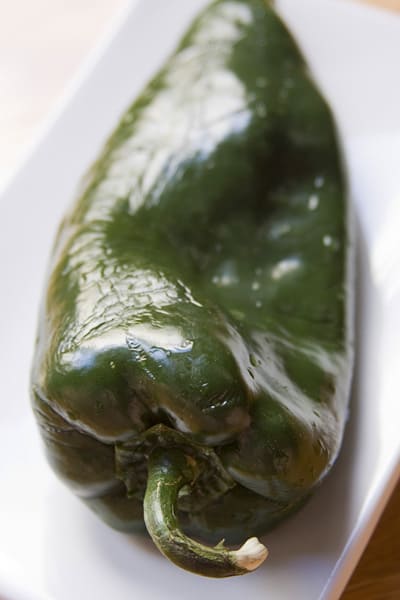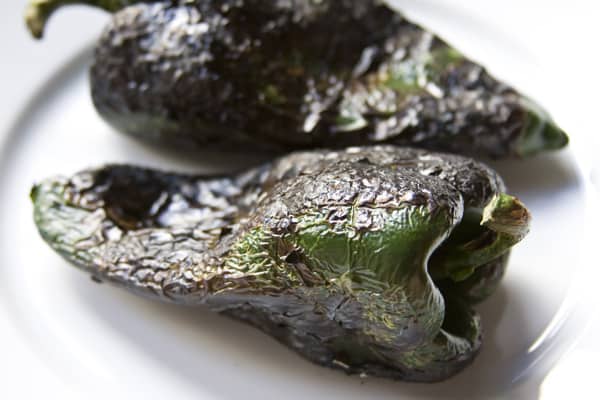
Over the years, I’ve been asked many times how to roast poblano peppers. It’s easier than you think, but takes a little bit of time because you have to roast, sweat, peel, seed and devein them to prepare them for use in a dish. Poblano chiles are used for a number of Mexican dishes such as chiles rellenos, chiles en nogada and rajas con crema, to name a few. I can’t think of many dishes I make without roasting the poblano chiles first, which gives them a more robust flavor. Poblano peppers are also called chile poblano, poblano chiles or, in some cases depending on the region, pasilla chiles. (These are not to be confused with the dried pasilla chile.)
I sometimes make the mistake of using my bare hands to peel, devein and remove the seeds of a poblano chile because it doesn’t smell too spicy. Usually each time I do, I get fooled and the back of my hands feel like they’re burning for the rest of the day. A few times, I’ve scratched my forehead only to feel the searing sensation and have a little red raspberry spot to show off my mistake.
You can save yourself from the burn by wearing fitted latex gloves.
There are several methods for roasting chiles. The two ways I prefer are over a direct flame or on a hot comal. Either way, be sure not to burn the meaty flesh of the chile or it will have a bitter taste. With both methods as the skin starts to blister, you’ll hear what sounds like little zaps of electricity or sizzling—that’s normal.
ROASTING POBLANO PEPPERS OVER A FLAME
- Place 1-2 chiles directly on the stove burners over a medium flame. Turn with kitchen tongs as each side blisters until the skin is toasted and blackened, but it should not blacken so much that it starts to peel or turn into ash. It should take a few minutes per side and about 10-12 minutes total, depending on how large they are.
- You can also follow this same method on a barbecue grill to roast more peppers at once.
ROASTING POBLANO PEPPERS ON A COMAL
- If you don’t have a comal (a flat, thin, and usually round or oval shaped pan for cooking tortillas), use a cast-iron or heavy non-stick skillet. Heat over medium flame and add 2-3 chiles to the comal. Turn them until the surfaces are toasted and blackened. The amount of time it takes will depend on whether you have a gas or electric stove and the thickness of your comal or skillet.

HOW TO SWEAT THE CHILES
Place the chiles in a sealed, plastic Ziploc bag to “sweat” for about 15 minutes. (You can also refrigerate the chiles for a day or two after sweating if you are not ready to peel, devein and remove the seeds for use.) Sweating has two purposes: first to remove the skin and then to cook the chile a bit further in its own vapors to acquire the characteristic taste of a freshly roasted chile. Have a bowl or plate ready to hold the skinned chiles.
Put on your latex gloves.
After 15 minutes, open the bag and one at a time, pinch part of the skin so it tears and peel it off. Remove the skins from each chile and transfer them to the bowl or plate you have waiting. Discard the skins.
HOW TO SEED AND DEVEIN POBLANO PEPPERS
To devein and remove the seeds, cut a slit along the side of the chile. Use your fingers to dislodge the seeds. Pull out what you can with your fingers and then using a slow but steady stream of cool water, rinse the inside of the chile. This should flood the rest of the seeds out if you knocked them loose but couldn’t remove them with your fingers.
Feel for any thick veins along the side of the chile. Using a small paring knife (and being careful not to pierce the skin) gently cut the veins away from the skin. Pat the chiles dry with a paper towel to remove any extra moisture inside and out.
Now the chiles are ready to prepare for a dish.
80
Good instructions and gorgeous photos. I’m not much of an environmentalist, but I do roast a lot of poblanos and I am pretty cheap, so I just put the roasted poblanos on a plate and cover them with a bowl for the shvitz.
In making Chile Rellenos, I had to rely on my poor memory to recreate my grandmother’s recipe. While the finished product was a success, the roasting of the peppers was the part that I could not remember…until now. I roasted the peppers in the oven and then placed them in plastic bags, but after reading your blog, I can clearly see my grandmother standing if front of her stove roasting the peppers over an open flame. She would make, on average, 80 to 100 Chile Rellenos by herself to feed our large family. After making them myself, I truly appreciate all the love that she put into the meals she prepared for our special occasions.
Ron, you always have great stories about your abuela! So glad this post could help bring back some memories and teach you how to recreate the chiles rellenos that she made.
I did this in Israel this summer to make a Moroccan dish. I was not warned to wear gloves or be super careful – my hands were burning 12 hours later after being bathed in yogurt, cheese, water, milk, aloe and anything else I could find.
Gloves. Are. A. Must.
Yes, the gloves are absolutely essential, especially if you are not used to cooking with spicy peppers! I keep a box of medical latex gloves under my sink now, so any time I decide to cook with chiles I have gloves at the ready.
Had to skin a lot of ancho peppers from the garden this year (yea), Instead of using a plastic or paper bag to steam after roasting I just threw them into a pot with a lid and it worked great.
Very helpful article. Good to know I can do this a day before, will help with the whole cooking process for Chile Rellenos.
I was trying to remember how my mom would roast these…thank you for saving me from yet another phone call to my mom. My recipe, unlike my mother’s, is a bit healthier so I’m excited to make these for dinner tonight! Gracias!
Call your mother Ruvi, she’s waiting.